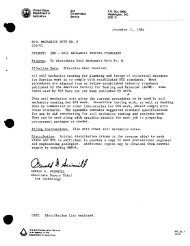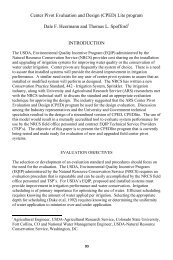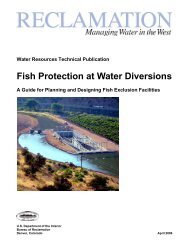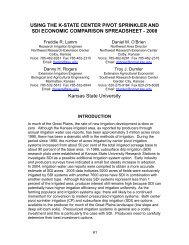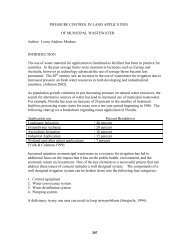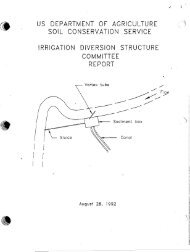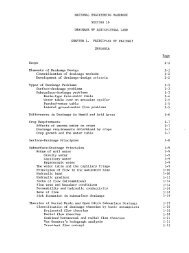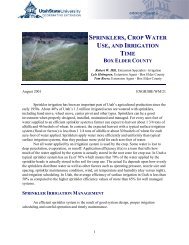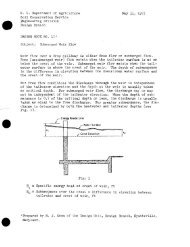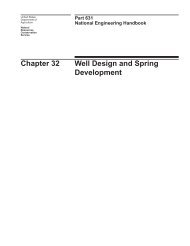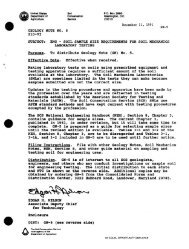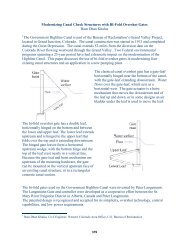Chapter 11: Sprinkle Irrigation - NRCS Irrigation ToolBox Home Page
Chapter 11: Sprinkle Irrigation - NRCS Irrigation ToolBox Home Page
Chapter 11: Sprinkle Irrigation - NRCS Irrigation ToolBox Home Page
You also want an ePaper? Increase the reach of your titles
YUMPU automatically turns print PDFs into web optimized ePapers that Google loves.
gation guides. In the absence of these, <strong>Chapter</strong> 1<br />
can be used to gain an insight into the computation<br />
process.<br />
WaterbHolding Capacity<br />
Soils of various textures have varying abilities to<br />
retain water. Except in the case of required periodic<br />
leaching, any irrigation beyond the field capacity of<br />
the soil is an economic loss. Table <strong>11</strong>-1, which was<br />
taken from <strong>Chapter</strong> 1, gives typical ranges of available<br />
water-holding capacities of soils of different<br />
textures (field capacity minus permanent wilting<br />
point) and is presented here for convenience. If local<br />
data are not available, the listed averages may be<br />
used as a guide.<br />
The total amount of soil water available for plant<br />
use in any soil is the sum of the available waterholding<br />
capacities of all horizons occupied by plant<br />
roots,<br />
Table <strong>11</strong>-1,-Range in available water-holding capacity<br />
of soils of different texture<br />
Inches of water per<br />
foot of depth<br />
Range Average<br />
1. Very coarse texture-very<br />
coarse sands 0.40 to 0.75 0.6<br />
2. Coarse texture-coarse<br />
sands, fine sands, and<br />
loamy sands 0.75 to 1.28 1.0<br />
3, Moderately coarse<br />
texture-sandy<br />
loams 1.25 to 1.75 1.5<br />
4. Medium texture-very fine<br />
sandy loams, loams, and<br />
silt loams 1.50 to 2.30 2.0<br />
5. Moderately fine textureclay<br />
loams, silty clay<br />
loams, and sandy clay<br />
loams 1.75 to 2.50 2.2<br />
6. Fine texture-sandy clays,<br />
silty clays, and clays 1.60 to 2.50 2.3<br />
7, Peats and mucks 2.00 to 3.00 2.5<br />
<strong>Chapter</strong> 1, Section 15, Soil-Plant- Water Relationships,<br />
Root Depth<br />
Typical plant f der root and total root depth are<br />
given in many references; however, the actual<br />
depths of rooting of the various crops are affected<br />
by soil conditions and should be checked at the site.<br />
Where local data are not available and there are no<br />
expected root restrictions, table <strong>11</strong>-2 can be used<br />
E~EJ a guide to estimating the effective root depths of<br />
various crops,<br />
The values given are averages selected from several<br />
references. They represent the depth at which<br />
crops will get most of their needed water when they<br />
are grown in a deep, well-drained soil that is adequately<br />
irrigated.<br />
Application Depth and Frequency<br />
For periodic-move, and low-frequency continuousmove<br />
systems such as traveling sprinklers, it is<br />
desirable to irrigate as infrequently as practical to<br />
reduce labor costs. A general rule of thumb for<br />
crops in arid and semiarid regions is that the soil<br />
moisture deficit (SMD) within the root zone should<br />
not fall below 50 percent of the total availablewater-holding<br />
capacity, This is a managementallowed<br />
deficit, MAD = 50%. It is also desirable to<br />
bring the moisture level back to field capacity with<br />
each irrigation; therefore, the duration of each irrigation<br />
is identical.<br />
In humid regions it is necessary to allow for rains<br />
during the irrigation period; however, the 50 percent<br />
limitation on soil moisture depletion should be<br />
followed for design purposes.<br />
Local soil conditions, soil management, water<br />
management, and economic considerations determine<br />
the amount of water used in irrigating and the<br />
rate of water application. The standard design approach<br />
has been to determine the amount of water<br />
needed to fill the entire root zone to field capacity<br />
and, then, to apply at one application a larger<br />
amount to account for evaporation, leaching, and<br />
efficiency of application. The traditional approach<br />
to the frequency of application has been to assume<br />
MAD = 50%, then take the number of inches of<br />
water in the root zone reservoir that can be extracted<br />
and, using the daily consumptive use rate of<br />
the plant, determine how long this supply will last.<br />
Such an approach is useful only as a guide to irrigation<br />
requirements because many factors affect the<br />
amount of irrigation water and the timing of applications<br />
for optimal design and operation of a system.



